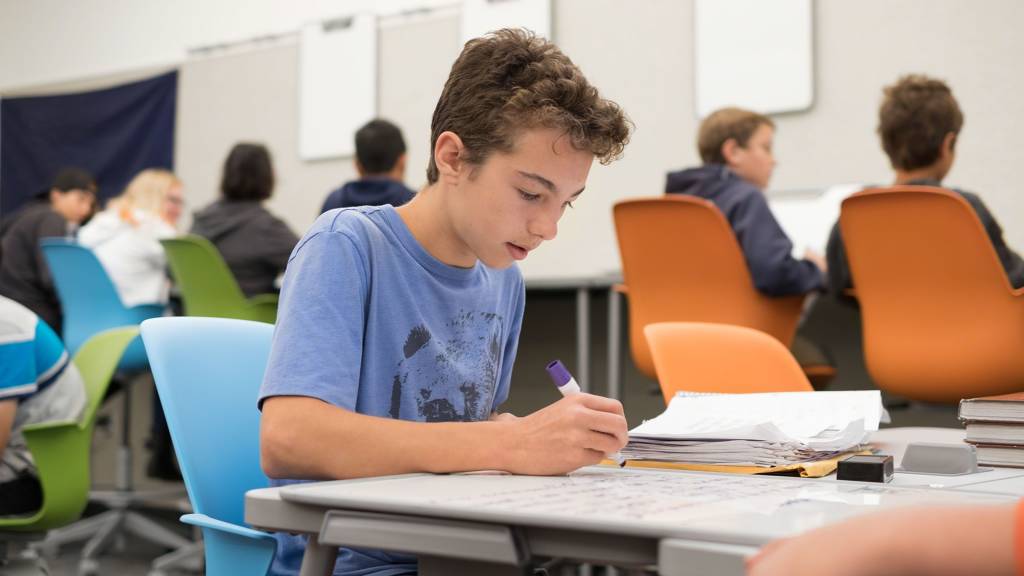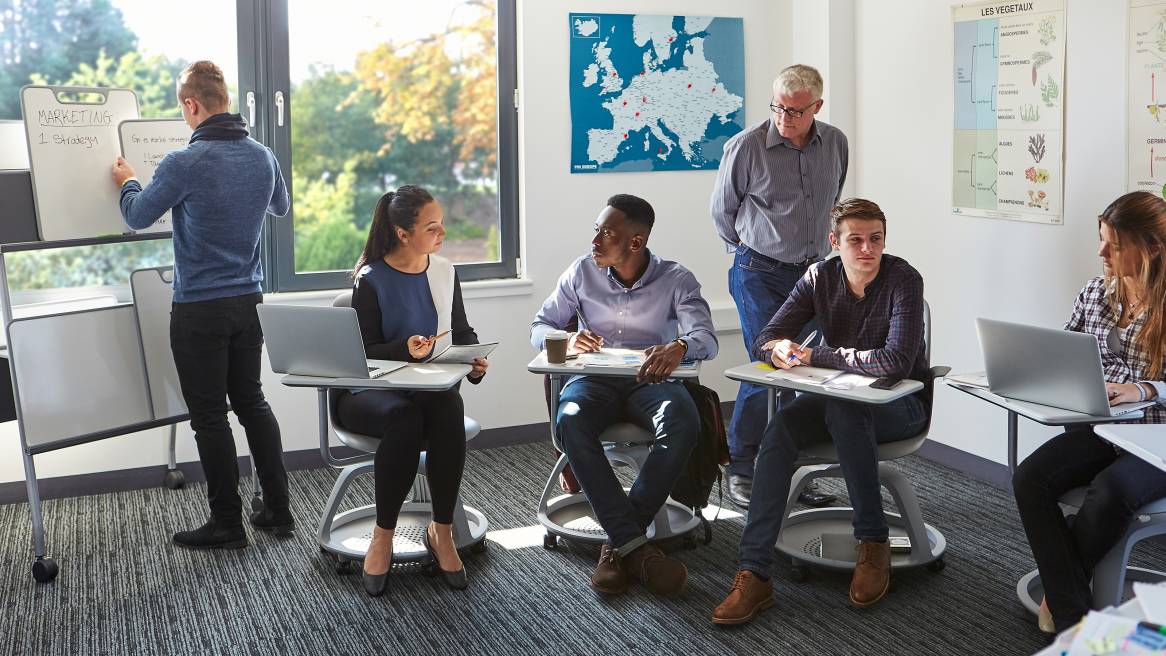Active Learning Centers Impact Education
After reimagining the classroom, 12 educational institutions found that their Active Learning Centers resulted in enhanced collaboration and supported instructor-led changes in pedagogy.
Cycle 1 Grant Recipients Share First Year Findings
Over the past academic year, 12 educational institutions have challenged themselves to inspire and innovate with classrooms designed to support active learning. As recipients of the Steelcase Education Active Learning Center Grant, their experiences may be instructive for those who seek to advance learning and teaching in new ways.
ABOUT THE GRANT
The Active Learning Center Grant invests in visionary educators and educational institutions that promote the advancement of active learning. As a grantmaker, Steelcase Education seeks to identify and support leading educators and educational institutions looking to implement and expand active learning initiatives by leveraging physical classroom space. Our interest centers on advancing our understanding of the impact of active learning on pedagogy, technology and the built space, acting in one holistic ecosystem.
The focus of this grant program is limited to classrooms for grades 6 – 12 or within a college or university, and located in the United States, Canada or Mexico.
CYCLE 1, YEAR 1
In Cycle 1, 12 grants were awarded, each providing one active learning classroom, including furniture, integrated technology, classroom design, installation, training and post-occupancy evaluation. Grant recipients chose from three types of classrooms designed for 28 – 32 students, valued in the range of $35,000 – $50,000, depending on the classroom application.
SUMMARY
After completing the first year of instruction in their new classrooms, participating educational institutions report that their Active Learning Centers:
- Enhanced collaboration and team-based learning
- Drove student engagement and participation
- Supported instructor-led changes in pedagogy
ABOUT THE STUDIES
Research methods
All Active Learning Center Grant recipients were provided with a post- occupancy measurement tool. Each institution was also encouraged to frame its own research intent and to complement the tool with additional classroom assessments. As such, findings highlighted in this report represent common themes that emerged from data gathered in various ways including, most commonly, student performance evaluations, classroom observations and student/ faculty surveys conducted before, during and after the school year.
Support for findings is highlighted by data and observations attributed to individual institutions.
Participants
| Institutions | Location | Steelcase Dealer Partners |
| Higher Ed | ||
| California State University | Los Angeles, CA | Tangram Interiors |
| Fairfield University | Fairfield, CT | Red Thread |
| HACC, Central Pennsylvania’s Community College | Harrisburg, PA | Phillips Office Solutions |
| Metropolitan Community College | Omaha, NE | Sheppard’s Business Interiors |
| The Ohio State University | Columbus, OH | LOTH |
| The University of West Alabama | Livingston, AL | DeKalb Office |
| University of Arizona | Tucson, AZ | Target Commercial Interiors |
| Grades 6-12 | ||
| Forest Hills Northern High School | Grand Rapids, MI | Custer |
| Grover Cleveland Middle School | Caldwell, NJ | DS&D |
| Hall Middle School | Larkspur, CA | One Workplace |
| P.K. Yonge Developmental Research High School | Gainesville, FL | OEC Business Interiors |
| Saluda Trail Middle School | Rock Hill, SC | White Office |
FINDING 1: ENHANCED COLLABORATIVE LEARNING
Educators who embrace more active learning approaches are often interested in nurturing collaboration and team learning experiences in their classrooms. By and large, Active Learning Center (ALC) Grant recipients report that their new spaces help them do this well.
Better, more frequent interactions
In a survey of Grover Cleveland Middle School students who used the ALC, 87.3% said that the classroom’s furniture made it easier to work with others. A student survey at the University of Arizona yielded similar results. More specifically, ALC students surveyed at Metropolitan Community College reported being more aware of fellow students, and better able to remember names and discussions with one another.
Increased movement and sharing
Many grantee institutions found that because the ALC’s mobile furniture reconfigures with ease, it led their instructors to do more team-based learning and group projects. They also indicated that whiteboards and advanced projection capabilities facilitated sharing among students and between students and instructors. Metropolitan Community College,The University of West Alabama and California State University reported these findings, drawing on faculty and/or student surveys.
At The University of West Alabama in particular, faculty survey data suggested that the flexible furnishings in the ALC allowed for more interactive, collaborative and participatory learning experiences. Students working in groups in the classroom were observed to gain confidence and demonstrate eagerness to share ideas with the class.
87.3% of students surveyed say ALC furniture makes it easier to work with others.
Grover Cleveland Middle School

FINDING 2: DROVE STUDENT ENGAGEMENT
Many grant recipient institutions reported greater student engagement on a number of dimensions as a result of their experience in an Active Learning Classroom.
New creativity and achievement
Students surveyed at Metropolitan Community College and at HACC, Central Pennsylvania’s Community College, reported higher levels of engagement in the ALC as compared to their experience in a traditional classroom. Most institutions reporting more attentive, participative students generally associated these behaviors with better outcomes. Student and instructor survey responses at P.K. Yonge Developmental Research High School suggested something further– that the new ALC contributed to an increased ability to achieve a higher grade, motivation to attend class and be creative.
Greater participation, motivation and focus
Grant recipients at The University of West Alabama and Metropolitan Community College found that the ALC experience had positive effects on students’ participation and focused attention in class. Some observed students to engage in more productive conversations than in traditional classroom settings.
Some grant recipients reported that the less-formal, more flexible setting within their ALC put students at ease, making way for higher quality learning experiences. Metropolitan Community College students reported that getting comfortable at the beginning of class took far less time in the ALC than in a traditional classroom. “Comfort is a great contributor to motivation,” according to a faculty fellow at The University of West Alabama.
More active, hands-on experiences
Some grant recipients reporting greater engagement attributed this benefit to the ALC’s mobile furnishings in particular.
Metropolitan Community College and HACC described how their students and instructors could easily create multiple configurations that support hands-on learning techniques known to foster engagement and mastery.
89.9% of students report being engaged when working in ALC classrooms.
Metropolitan Community College

FINDING 3: SUPPORTED INSTRUCTOR-LED CHANGES IN PEDAGOGY
Shifting to new, more active, student- centered methods of teaching and learning can be challenging. By and large, instructors in ALC classrooms reported feeling more creative, motivated and satisfied as they made this transition.
More creative and student centered
The grantee team at P.K. Yonge Developmental Research High School reported that the ALC space allowed for more creative, student-centered instruction. Similarly, University of Arizona faculty members indicated in their survey that the ALC inspired more creative teaching methods. Many grantees described how, for example, individual whiteboards and classroom easels invited a variety of uses, fostering greater student expression and inspiring new teaching techniques. In contrast to traditional classrooms equipped for “sage on the stage” lecture-style pedagogies, flexible ALC furnishings supported the shift from lecture-dominant teaching to more immersive, mutually engaging experiences.
Wide range of options and easy transitions
Some institutions, including Fairfield University and Metropolitan Community College, reported that their faculty members were able to employ a wider range of teaching pedagogies in the ALC, such as class discussion, partner and small group work, hands-on activities, use of media and interactive polling, and other techniques. Many grant recipients indicated that mobility and options afforded by the ALC classroom supported ongoing changes to pedagogy. Further, some instructors described an improved ability to move around the ALC during class. The Ohio State University reported that its educators are adopting “movement” as a pedagogy change in and of itself.

“The flexible furniture gave me a chance to be more inventive.”
InstructorThe Ohio State University
A positive tone, a satisfying experience
ALC Grant recipient institutions described a generally more positive experience for instructors and students alike. Fairfield University faculty members reported feeling more motivated and satisfied with their teaching in the ALC. Members of the Metropolitan Community College faculty reported that the mobile furnishings allowed them to create non-traditional configurations, setting a positive tone and expectation for students.
STORIES IN ACTIVE LEARNING
Saluda Trail Middle School saw increased parent participation and student achievement Saluda Trail Middle School in Rock Hill, South Carolina, serves more than 850 students, 30% of whom are below grade level. The school’s commitment to project-based learning was long constrained by classroom furnishings: heavy metal desks and unstable bookshelves, poor projection tools and lighting.
After one year in a new Active Learning Center, Saluda Trails reported several improvements.
Parent participation surged. When visiting the school, parents could immediately see and feel the difference between the ALC classroom and the ones they remembered growing up. “Because so many of our students are from generational poverty, parents are often skeptical of coming to school as they harbor negative attitudes based on their own classroom experiences,” says Dr. Julie Marshall, a 7th-grade English Language Arts teacher in the ALC. “The ALC has changed what parents feel and do for their students’ school.”
In one year, the parent volunteer rate has doubled, attendance at parent-teacher conferences has increased and teachers have noticed improved parent support
at home.
Students felt and behaved more positively. “Every day they look forward to getting in the room,” says Marshall. “They meet me with hugs in the hallway, thanking me for this classroom.” Teachers have observed new student attitudes and behaviors, with apathy giving way to a desire to learn.
The University of West Alabama sparked new behaviors with students at the center
Located in Livingston, Alabama, The University of West Alabama proposed an Active Learning Center to replace a traditional classroom serving a range of students and courses, from freshmen to graduate level. After one year in the ALC, the University reported positive results for teachers and teaching, as well as students and learning.
Teaching became more student centered. Classroom observations, student surveys and faculty interviews indicated a shift toward a more student- centered approach to teaching, where students explore, communicate and elaborate on the content being taught.
Students were more alert and focused. Some faculty fellows reported that the ALC facilitated learning by keeping students more alert and focused. They reported better learning outcomes and faster processing of concepts and techniques among their students.
Accordingly, post-occupancy student scores on participation and focused attention are significantly higher than pre-occupancy scores.
Interactions were more supportive and confident. Comparing courses taught in a traditional classroom to those taught in the ALC by the same instructor, the ALC experience was observed to differ in these ways:
- Instructor-student knowledge exchange was more like a conversation with both parties equally engaged and encouraged to express ideas freely
- Instructors were very mobile, constantly changing their location in the room to engage and motivate more students
- Instructors encouraged the use of many different types of technology, helping students learn to explore and think creatively and critically
- Students working in groups seemed to gain confidence and were eager to participate and share their ideas and conclusions with the class using personal whiteboards
“Students are excited about the new learning environment and experience… They feel comfortable here, and that contributes to their motivation for learning.”
Survey, The University of West Alabama
P.K. Yonge Developmental Research High School improved teaching practice and learning experience
A high school in Gainesville, Florida, P.K. Yonge made its new Active Learning Center classroom available to 11th-grade Honors English and AP English Language students. One year in, P.K. Yonge reported that the new environment had a significant impact on learning.
Students were engaged and motivated. Students using the ALC said that the new classroom contributed to a better learning experience by increasing comfort, movement and the space
they needed to work. Both students and instructors credit the classroom with moderate to major increases in the following behaviors:
- Student engagement
- Ability to achieve a higher grade
- Motivation to attend class and be creative
Learning modes change with fluidity. The school provided this narrative describing the effects of the ALC on an English class:
On an essay-drafting day, a student writing group used laptops and document-sharing to evaluate each other’s drafts. Two tables, when pushed together, easily accommodated a writing group of five to six students and their materials. One student in the group used a whiteboard to record group questions, and whiteboard notes on easels and brackets around the room gave reminders to writers, such as keyboard shortcuts, outline tips and sequences, and fixes for common spelling or mechanics errors. All of these processes could have taken place in some form in a traditional space, but not nearly so seamlessly. In the ALC, these tasks were accomplished with minimal loss of time and students’ attention.
“In the ALC, these tasks were accomplished with minimal loss of time and students’ attention.”
Classroom observer, P.K. Yonge Developmental Research High School
CONCLUSION
With positive results, the progress continues
The experiences and outcomes reported by the first 12 schools and colleges that completed one academic year in their new classrooms through the Active Learning Center Grant Program are positive and encouraging. Steelcase Education hopes the grantee data and stories create inspiration for others seeking to stimulate new, more active modes of learning and teaching.
The research also reveals new challenges and opportunities for improvement. For example, one grantee expressed a need for more proactive and in-depth training of faculty to ensure full use of the Active Learning Center resources. Steelcase Education will continue to learn together with grantees to maximize the effectiveness of the space and achieve desired outcomes.
In the meantime, this program continues, with the institutions described here in their second year of the use and assessment period – and a cycle comprising 13 additional ALC Grant recipients now settling into new classrooms.
We will continue to report findings as they become available, bringing insights learned into our approach to active learning and to all engaged in the future of learning and teaching.
Learn more
To find out more about the Active Learning Center Grant, visit our website to see videos featuring Cycle 1 grantees, complete research studies from each school and additional resources.


